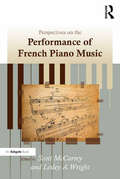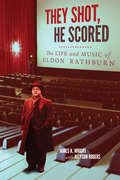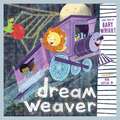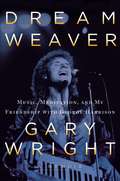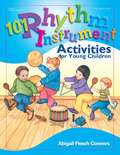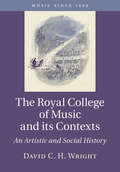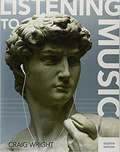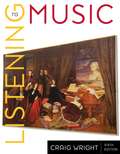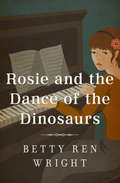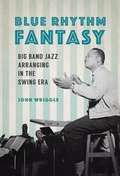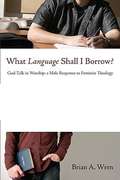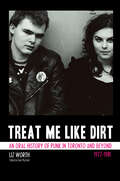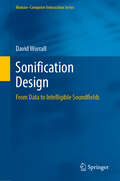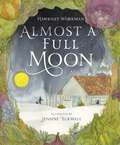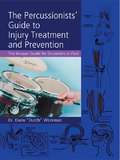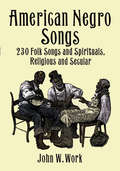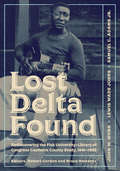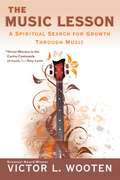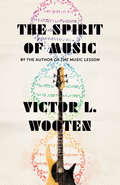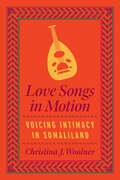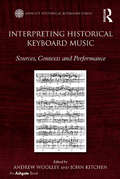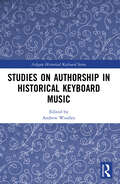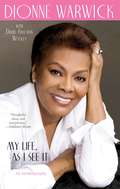- Table View
- List View
Perspectives on the Performance of French Piano Music
by Lesley A. WrightPerspectives on the Performance of French Piano Music offers a range of approaches central to the performance of French piano music of the nineteenth and twentieth centuries. The contributors include scholars and active performers who see performance not as an independent activity but as a practice enriched by a wealth of historical and analytical approaches. To underline the usefulness of contextual understanding for performance, each author highlights the choices performers must confront with examples drawn from particular repertoires and composers. Topics explored include editorial practice, the use of early recordings, emergent disciplines such as analysis-and-performance, and traditions passed down from teacher to student. Themes that emerge demonstrate the importance of editions as a form of communication, the challenges of notation, the significance of detail and of deeper continuity, the importance of performing and teaching traditions, and the influence of cross disciplinary frameworks. A link to a set of performed examples on the frenchpianomusic.com website allows readers to hear and compare performances and interpretations of the music discussed. The volume will appeal to musicologists and analysts interested in performance, performers, students, and piano teachers.
Punks in Peoria: Making a Scene in the American Heartland (Music in American Life #1)
by Jonathan Wright Dawson BarrettPunk rock culture in a preeminently average town Synonymous with American mediocrity, Peoria was fertile ground for the boredom- and anger-fueled fury of punk rock. Jonathan Wright and Dawson Barrett explore the do-it-yourself scene built by Peoria punks, performers, and scenesters in the 1980s and 1990s. From fanzines to indie record shops to renting the VFW hall for an all-ages show, Peoria's punk culture reflected the movement elsewhere, but the city's conservatism and industrial decline offered a richer-than-usual target environment for rebellion. Eyewitness accounts take readers into hangouts and long-lost venues, while interviews with the people who were there trace the ever-changing scene and varied fortunes of local legends like Caustic Defiance, Dollface, and Planes Mistaken for Stars. What emerges is a sympathetic portrait of a youth culture in search of entertainment but just as hungry for community—the shared sense of otherness that, even for one night only, could unite outsiders and discontents under the banner of music. A raucous look at a small-city underground, Punks in Peoria takes readers off the beaten track to reveal the punk rock life as lived in Anytown, U.S.A.
They Shot, He Scored: The Life and Music of Eldon Rathburn
by James K. WrightEldon Davis Rathburn (1916-2008), one of the most multi-dimensional, prolific, and endlessly fascinating composers of the twentieth century, wrote more music than any other Canadian composer of his generation. During a long and productive career that spanned seventy-five years, Rathburn served for thirty years as a staff composer with the National Film Board of Canada (1947-76), scored the first generation of IMAX films, and created a diverse catalogue of orchestral and chamber works. With the aid of extensive archival and documentary materials, They Shot, He Scored chronicles Rathburn's life and works, beginning with his formative years in Saint John, New Brunswick, and his breakthrough in Los Angeles in connection with Arnold Schoenberg and the LA Philharmonic Orchestra. The book follows his work at the NFB, his close encounters with some of the most celebrated international figures in his field, and his collaboration with the team of innovators who launched the IMAX film corporation. James Wright undertakes a close analytical reading of Rathburn's film and concert scores to outline his methods, compositional techniques, influences, and idiosyncratic approach to instrumentation, as well as his proto-postmodern proclivity for borrowing from diverse styles and genres. Authoritative and insightful, They Shot, He Scored illuminates the extraordinary career of an unsung creative force in the film and music industry.
Dream Weaver: A Children's Picture Book (LyricPop #0)
by Gary WrightGary Wright's hit song is reimagined as a fantastical picture book to delight dreamers of all ages. "Oo-hoo dream weaver I believe you can get me through the night Oo-hoo dream weaver I beli
Dream Weaver: A Memoir; Music, Meditation, and My Friendship with George Harrison
by Gary WrightMusic legend Gary Wright reflects on his professional collaboration, friendship, and spiritual journey with "quiet Beatle" George Harrison. Best known for his multiplatinum hits "Dream Weaver" and "Love is Alive," Gary Wright came to prominence as a singer and songwriter during the golden age of rock in the 1970s. What is not as well known to the public, however, is Wright's spiritual side. At the heart of this memoir is the spiritual conversion and journey that Wright experienced alongside his close friend George Harrison. Until Harrison's death in 2001, the two spent decades together writing songs, eating Indian fare, talking philosophy, and gardening. In addition to featuring lyrics to a never-released recording of a song cowritten by Wright and George Harrison in 1971, titled "To Discover Yourself," this memoir includes a cache of never-before-seen photos. Also available is a deluxe e-book featuring an audio recording of "To Discover Yourself."
101 Rhythm Instrument Activities for Young Children
by Deborah Wright Joan Waites Abigail Flesch ConnorsThe perfect book to introduce rhythm instruments to young children! Children make the sound of the ocean waves using shakers, pretend to be a train using sand blocks, create a rainstorm with rhythm sticks, and perform circus tricks with jingle bells. Plus, they learn to play the instruments along with their favorite songs. 101 Rhythm Instrument Activities /i>is perfect for parents, early childhood teachers, and music teachers who work with toddlers through age 6.
The Royal College of Music and its Contexts: An Artistic and Social History (Music since 1900)
by David C. WrightLocated between the great Victorian museums of South Kensington and the Royal Albert Hall, the Royal College of Music, founded in 1883, has been a central influence on British musical life ever since. This wide-ranging account places the College within its musical and educational environments. It argues that the RCM's significance lies not only in its famous performers and composers, but also the generations of its more anonymous former students who have done so much to improve the musical life of the localities in which they have worked as teachers and animateurs. As a cultural history, this account also captures how significantly society's consumption of music - from new technologies to the altered perspectives of historical and world musics - has changed since the College was founded, and how very different our points of musical reference now are. This study traces the effects of such developments on the College's work.
Listening to Music
by Craig WrightCombining a student-friendly presentation with cutting-edge digital resources, LISTENING TO MUSIC equips you with the tools to actively listen to and inspire a lifelong appreciation for music. Known for his clear, conversational style, Professor Wright helps you immediately find connections to music by comparing pop and classical music concepts. His text is organized chronologically and discusses musical examples from each era in its social context -- describing the construction and culture of each piece.
Listening to Music
by Craig WrightDesigned for an introductory course in music appreciation, this lavishly illustrated textbook encourages students to become active listeners who engage personally with what they are hearing. Sound files for the listening exercises are contained on the two accompanying CDs. Wright teaches music at Yale U. Annotation ©2007 Book News, Inc. , Portland, OR (booknews. com)
Rosie and the Dance of the Dinosaurs
by Betty Ren WrightThe big piano recital is coming up soon, and Rosie feels anything but ready—&“captures the down-to-earth rhythms of suburban life, spiced with humor&” (Kirkus Reviews). Even though Rosie has only nine fingers, she&’s always managed well. Until now. For some reason, she can&’t master the piano solo she&’s been rehearsing for the annual recital. It&’s called &“The Dance of the Dinosaurs,&” and it&’s hard! As the recital draws near, Rosie is desperate. Why does everything seem so much more difficult now? Is it because she misses her father? Since he moved to Milwaukee to take a new job, Rosie&’s been miserable, and her mother has been acting kind of strange. Or is Rosie having trouble because she&’s worried about the burglar who&’s been secretly visiting her house? Then, too, there&’s Mary Jean, the new girl in town. Not only is she rich and pretty, but she plays the piano beautifully. In the weeks before the recital, Rosie fights some hard battles. To her surprise, she discovers that having nine fingers isn&’t such a bad thing after all.
Blue Rhythm Fantasy: Big Band Jazz Arranging in the Swing Era
by John WriggleBehind the iconic jazz orchestras, vocalists, and stage productions of the Swing Era lay the talents of popular music's unsung heroes: the arrangers. John Wriggle takes you behind the scenes of New York City's vibrant entertainment industry of the 1930s and 1940s to uncover the lives and work of jazz arrangers, both black and white, who left an indelible mark on American music and culture. Blue Rhythm Fantasy traces the extraordinary career of arranger Chappie Willet--a collaborator of Louis Armstrong, Cab Calloway, Duke Ellington, Gene Krupa, and many others--to revisit legendary Swing Era venues and performers from Harlem to Times Square. Wriggle's insightful music analyses of big band arranging techniques explore representations of cultural modernism, discourses on art and commercialism, conceptions of race and cultural identity, music industry marketing strategies, and stage entertainment variety genres. Drawing on archives, obscure recordings, untapped sources in the African American press, and interviews with participants, Blue Rhythm Fantasy is a long-overdue study of the arranger during this dynamic era of American music history.
What Language Shall I Borrow?: A Male Response to Feminist Theology
by Brian A. WrenThe author of this book writes from the experience of being English, white, male, and heterosexual, and as one who values the Reformed tradition and has been shaped and enriched by it.
Treat Me Like Dirt: An Oral History of Punk in Toronto and Beyond, 1977–1981
by Liz WorthThis compendium of interviews with key players in the Toronto punk scene is &“easily one of the best rock biographies you&’ll read this year.&” (Montreal Mirror) Treat Me Like Dirt captures the personalities that drove the original Toronto punk scene. This is the first book to document the histories of the Diodes, Viletones, and Teenage Head, along with other bands such as the B-Girls, Curse, Demics, Dishes, Forgotten Rebels, Johnny & the G-Rays, the Mods, the Poles, Simply Saucer, the Ugly and more. Also included are interviews from fans that brought the punk scene to life in Toronto. This book is a punk rock road map, full of chaos, betrayal, pain, disappointments, failure, success, and the pure rock &’n&’ roll energy that frames this layered history of punk in Toronto and beyond. Treat Me Like Dirt is a story assembled from individual personal stories that go beyond the usual &“we played here, this famous person saw us there&” and into sex, drugs, murder, conspiracy, booze, criminals, biker gangs, violence, art (yes, art) and includes one of the last interviews with the late Frankie Venom, the singer of Teenage Head. Including a wealth of previously unpublished photographs, Treat Me Like Dirt is the uncensored oral history of the 1977 Toronto punk explosion. Exclusive to this edition is a selected discography of all key Toronto punk releases referenced in the book, contributed by Frank Manley, author of Smash The State, the acclaimed and pioneering discography of Canadian punk, and subsequent vinyl compilations, that activated the current international interest in Canadian punk from the &‘70s and early &‘80s.
Sonification Design: From Data to Intelligible Soundfields (Human–Computer Interaction Series)
by David WorrallThe contemporary design practice known as data sonification allows us to experience information in data by listening. In doing so, we understand the source of the data in ways that support, and in some cases surpass, our ability to do so visually. In order to assist us in negotiating our environments, our senses have evolved differently. Our hearing affords us unparalleled temporal and locational precision. Biological survival has determined that the ears lead the eyes. For all moving creatures, in situations where sight is obscured, spatial auditory clarity plays a vital survival role in determining both from where the predator is approaching or to where the prey has escaped. So, when designing methods that enable listeners to extract information from data, both with and without visual support, different approaches are necessary. A scholarly yet approachable work by one of the recognized leaders in the field of auditory design, this book will - Lead you through some salient historical examples of how non-speech sounds have been used to inform and control people since ancient times. - Comprehensively summarize the contemporary practice of Data Sonification. - Provide a detailed overview of what information is and how our auditory perceptions can be used to enhance our knowledge of the source of data. - Show the importance of the dynamic relationships between hearing, cognitive load, comprehension, embodied knowledge and perceptual truth. - Discuss the role of aesthetics in the dynamic interplay between listenability and clarity. - Provide a mature software framework that supports the practice of data sonification design, together with a detailed discussion of some of the design principles used in various examples. David Worrall is an internationally recognized composer, sound artist and interdisciplinary researcher in the field of auditory design. He is Professor of Audio Arts and Acoustics at Columbia College Chicago and a former elected president of the International Community for Auditory Display (ICAD), the leading organization in the field since its inception over 25 years ago.Code and audio examples for this book are available athttps://github.com/david-worrall/springer/ Here is an excellent review of the book by Dr Gregory Kramer: “Worrall proceeds bravely through the trees and vines of philosophy, information theory, aesthetics, and other contributors to sonification design theory. It’s a feat. He nails all of this down with the specific implementation system he’s designed over many years, and applies his theories to specific problems. In a field of research still in its first half century and setting its bearings in a world where human perception has become a sideshow to machine learning, deep learning, and artificial intelligence, the roots David provides will serve well.” Dr Gregory Kramer is the founding figure in the emerging field of sonification, founded the International Conference on Auditory Display (ICAD) and editor of the first book in the field, "Auditory Display: Sonification, Audification and Auditory Interfaces" (Addison Wesley, 1994).
Almost a Full Moon
by Hawksley WorkmanAlmost a Full Moon is a warm-hearted story of family, community, food and home. A boy and his grandmother host a gathering in their small cabin in the middle of winter. Friends travel from near and far, and some new friends even turn up. The walls of the cabin are elastic and the soup pot bottomless; all are welcome. Based on the lyrics of Hawksley Workman's song from his holiday album Almost a Full Moon, this book evokes both the cold and the coziness of a winter's night: crisp clean air, sparkling snow, the light of the moon, welcoming windows, glowing candles, family and friends. The spare text is beautifully complemented with the rich illustrations of Jensine Eckwall, a new talent to Tundra. She brings beauty and a hint of magic to Workman's evocative lyrics; together, they create a world and a night that will enchant readers of all ages.
The Percussionists' Guide to Injury Treatment and Prevention: The Answer Guide to Drummers in Pain
by Dr. Darin WorkmanPain and injury are near constant companions for professional musicians. Aching hands, painful joint swelling, back problems, among other ailments were all thought to be part of the price musicians had to pay to be performers. However, thanks to an increasing awareness of both the kinesiology and biology of movement, as well as proper techniques for fostering good performance habits, musicians no longer have to suffer in silence.Perhaps no group of musicians has been more prone to career-threatening injury than percussionists, and the demands for speed, power, control, and endurance are only increasing. Often musicians wait until an injury is so aggravated that it's too late to be fully treated. In almost every case, if the drummer had done some very simple preventative (or early) care, the injury would never have become a serious issue.The Percussionists' Guide to Injury Treatment and Prevention is designed to aid in that early prevention and treatment. Although it is not a substitute for clinical diagnosis or medical care from a trained physician, it can educate the musician as to how the human body works; the role of muscles and skeletal structure in supporting movement; and understanding specifically how to prevent and treat common injuries. The book begins with a general discussion of how the body works and basic prevention concepts. It then covers each specific area of the body (where it hurts), suggesting practical ways to prevent and treat it. Basic anatomy is covered in terms that a musician can understand.For all percussion students and professionals, The Percussionists' Guide to Injury Treatment and Prevention will be an indispensable companion.
American Negro Songs: 230 Folk Songs and Spirituals, Religious and Secular
by John W. WorkFrom joyous gospel to deeply felt blues, this wonderful collection contains vintage songs sung and played through the years by black Americans — at work, in church, and for pure entertainment. Included are spirituals, blues, work songs, and a variety of social and dance songs.This important volume was originally compiled in 1940 by Dr. John W. Work, the noted musicologist affiliated with Fisk University and the celebrated Fisk Jubilee Singers. In it, he discusses the origins and history of black American folk music, the influence of slavery and African cultures, and the lyric significance of such much-loved songs as "Swing Low, Sweet Chariot," Steal Away to Jesus," "Lord, I Want to Be a Christian," and "John Henry." These informative notes lead up to the heart of the book: the complete words and music for 230 religious and secular songs, including "Study War No More," "Keep Me from Sinking Down," "You May Bury Me in the East," "Rock of Ages," "Go Tell It on the Mountain," and many others.This is an indispensable treasury of music for singers, musicians and all readers seeking a comprehensive sourcebook of black American folk music. It will be equally welcomed at parties, family get-togethers, sing-alongs, church events, and other gatherings where people want to play and sing these classic folk songs that are an integral part of American musical history.
Lost Delta Found: Rediscovering the Fisk University-Library of Congress Coahoma County Study, 1941-1942
by John W. Work III Lewis Wade Jones Samuel C. Adams Jr.Blues Hall of Fame Inductee—Named a "Classic of Blues Literature" by the Blues Foundation, 2019 This remarkable book recovers three invaluable perspectives, long thought to have been lost, on the culture and music of the Mississippi Delta. In 1941 and '42 African American scholars from Fisk University—among them the noted composer and musicologist John W. Work, sociologist Lewis Wade Jones, and graduate student Samuel C. Adams Jr.—joined folklorist Alan Lomax of the Library of Congress on research trips to Coahoma County, Mississippi. Their mission was to explore the musical habits and history of the black community there and "to document adequately the cultural and social backgrounds for music in the community." Among the fruits of the project were the earliest recordings by the legendary blues singer and guitarist Muddy Waters. The hallmark of the study was to have been a joint publication of its findings by Fisk and the Library of Congress. However, the field notes and manuscripts by the Fisk researchers became lost in Washington. Lomax's own book drawing on the project's findings, The Land Where the Blues Began, did not appear until 1993, and although it won a National Book Critics Circle Award, it was flawed by a number of historical inaccuracies. Recently uncovered by author and filmmaker Robert Gordon, the writings, interviews, notes, and musical transcriptions produced by Work, Jones, and Adams in the Coahoma County study now appear in print for the first time. Their work captures, with compelling immediacy, a place, a people, a way of life, and a set of rich musical traditions as they existed sixty years ago. Until the surfacing of these documents, Lomax's perspective was all that was known of the Coahoma County project and its research. Now, at last, the voices of the other contributors can be heard. Including essays by Bruce Nemerov and Gordon on the careers and contributions of Work, Jones, and Adams, Lost Delta Found will become an indispensable historical resource, as marvelously readable as it is enlightening. Illustrated with photos and more than 160 musical transcriptions.
Lost Delta Found: Rediscovering the Fisk University-Library of Congress Coahoma County Study, 1941-1942
by John W Work III Lewis Wade Jones Samuel C Adams JrBlues Hall of Fame Inductee—Named a "Classic of Blues Literature" by the Blues Foundation, 2019 This remarkable book recovers three invaluable perspectives, long thought to have been lost, on the culture and music of the Mississippi Delta. In 1941 and &’42 African American schol-ars from Fisk University—among them the noted composer and musicologist John W. Work III, sociologist Lewis Wade Jones, and graduate student Samuel C. Adams Jr.—joined folklorist Alan Lomax of the Library of Congress on research trips to Coahoma County, Mississippi. Their mission was &“to document adequately the cultural and social backgrounds for music in the community.&” Among the fruits of the project were the earliest recordings by the legendary blues singer and guitarist Muddy Waters. The hallmark of the study was to have been a joint publication of its findings by Fisk and the Library of Congress. While this publication was never completed, Lost Delta Found is composed of the writings, interviews, notes, and musical transcriptions produced by Work, Jones, and Adams in the Coahoma County study. Their work captures, with compelling immediacy, a place, a people, a way of life, and a set of rich musical traditions as they existed in the 1940s. Illustrated with photos and more than 160 musical transcriptions.
The Music Lesson: A Spiritual Search for Growth Through Music
by Victor L. WootenFrom Grammy-winning musical icon and legendary bassist Victor L. Wooten comes The Music Lesson, the story of a struggling young musician who wanted music to be his life, and who wanted his life to be great. Then, from nowhere it seemed, a teacher arrived. Part musical genius, part philosopher, part eccentric wise man, the teacher would guide the young musician on a spiritual journey, and teach him that the gifts we get from music mirror those from life, and every movement, phrase, and chord has its own meaning...All you have to do is find the song inside.
The Spirit of Music: The Lesson Continues
by Victor L. WootenGrammy Award winner Victor Wooten's inspiring parable of the importance of music and the threats that it faces in today's world. A VINTAGE ORIGINALWe may not realize it as we listen to the soundtrack of our lives through tiny earbuds, but music and all that it encompasses is disappearing all around us. In this fable-like story three musicians from around the world are mysteriously summoned to Nashville, the Music City, to join together with Victor to do battle against the "Phasers," whose blinking "music-cancelling" headphones silence and destroy all musical sound. Only by coming together, connecting, and making the joyful sounds of immediate, "live" music can the world be restored to the power and spirit of music.
Love Songs in Motion: Voicing Intimacy in Somaliland (Chicago Studies in Ethnomusicology)
by Christina J. WoolnerAn intimate account of everyday life in Somaliland, explored through an ever-evolving musical genre of love songs. At first listen, both music and talk about love are conspicuously absent from Somaliland’s public soundscapes. The lingering effects of war, the contested place of music in Islam, and gendered norms of emotional expression limit opportunities for making music and sharing personal feelings. But while Christina J. Woolner was researching peacebuilding in Somaliland’s capital, Hargeysa, she kept hearing snippets of songs. Almost all of these, she learned, were about love. In these songs, poets, musicians, and singers collaborate to give voice to personal love aspirations and often painful experiences of love-suffering. Once in circulation, the intimate and heartfelt voices of love songs provide rare and deeply therapeutic opportunities for dareen-wadaag (feeling-sharing). In a region of political instability, these songs also work to powerfully unite listeners on the basis of shared vulnerability, transcending social and political divisions and opening space for a different kind of politics. Taking us from 1950s recordings preserved on dusty cassettes to new releases on YouTube and live performances at Somaliland’s first postwar music venue—where the author herself eventually takes the stage—Woolner offers an account of love songs in motion that reveals the capacity of music to connect people and feelings across time and space, creating new possibilities for relating to oneself and others.
Interpreting Historical Keyboard Music: Sources, Contexts and Performance (Ashgate Historical Keyboard Series)
by Andrew Woolley John KitchenResearch in the field of keyboard studies, especially when intimately connected with issues of performance, is often concerned with the immediate working environments and practices of musicians of the past. An important pedagogical tool, the keyboard has served as the ’workbench’ of countless musicians over the centuries. In the process it has shaped the ways in which many historical musicians achieved their aspirations and went about meeting creative challenges. In recent decades interest has turned towards a contextualized understanding of creative processes in music, and keyboard studies appears well placed to contribute to the exploration of this wider concern. The nineteen essays collected here encompass the range of research in the field, bringing together contributions from performers, organologists and music historians. Questions relevant to issues of creative practice in various historical contexts, and of interpretative issues faced today, form a guiding thread. Its scope is wide-ranging, with contributions covering the mid-sixteenth to early twentieth century. It is also inclusive, encompassing the diverse range of approaches to the field of contemporary keyboard studies. Collectively the essays form a survey of the ways in which the study of keyboard performance can enrich our understanding of musical life in a given period.
Studies on Authorship in Historical Keyboard Music (Ashgate Historical Keyboard Series)
by Andrew WoolleyAuthorship is a pertinent issue for historical musicology and musicians more widely, and some controversies concerned with major figures have even reached wider consciousness. Scholars have clarified some of the issues at stake in recent decades, such as the places of borrowing and arranging in the creative process and the wider cultural significance of these practices. The discovery of new sources and methodologies has also opened up opportunities for reassessing specific authorship problems. Drawing upon this wider musicological literature as well as insights from other disciplines, such as intellectual history and book history, this book aims to build on what has already been achieved by focussing on keyboard music. The nine chapters cover case studies of authorship problems, the socioeconomic conditions of music publishing, the contributions of composers, arrangers, copyists and music publishers in creating notated keyboard compositions, the functions of attribution and ascription, and how the contexts in which notated pieces were used affected concepts of authorship at different times and places.
My Life, as I See It
by David F Wooley Dionne WarwickDionne Warwick made her singing debut in church at the request of her grandfather, the Reverend Elzae Warrick, when she was six years old. No one knew then that she would become an international music legend, but what she knew--as words of wisdom passed down from her grandfather--was that "if you can think it, you can do it." And she did it. Dionne released the first of more than fifty-six charted hits in 1962 with "Don't Make Me Over," followed by "Anyone Who Had a Heart," "Walk On By," "I Say a Little Prayer," "Alfie," and "A House Is Not a Home," to name a few. She received her first Grammy in 1968 for "Do You Know the Way to San Jose" and later recorded the classic hit "That's What Friends Are For." She was considered the voice of Burt Bacharach/Hal David compositions, and the rest is here, in her first autobiography. Dionne tells the stories of her life from her childhood in East Orange, New Jersey, in a two-family home with her parents, brother, and sister, to now, as she celebrates her fiftieth year in show business. She came by her musical gifts honestly. Her mother, Lee Drinkard Warrick, was a founding member of the legendary Drinkard Jubilairs, which included her mother's siblings Cissy, Marie, Annie, Nick, and Larry. Cissy went on to become a celebrated recording artist in her own right; she lived in the Warrick household, got married, and later gave birth to one of the most popular singers of our time, Whitney Houston. Dionne went on to start her own gospel group with her sister, Dee Dee, called the Gospelaires. Her father, once a Pullman porter, became an accountant, went on to promote gospel records for Hob Records, and wrote a book on gospel music. She attributes her strong family, who are faithful and industrious Christians, for keeping her grounded and giving her the fortitude, as well as the talent, to earn her place among world-class performing artists without losing herself or her soul.
